By: Nathan Beauchamp-Mustafaga
Introduction
As information becomes ever more central for Chinese warfighting, the People’s Liberation Army (PLA) is developing a new concept for psychological warfare in the information era called “cognitive domain operations” (认知域作战, renzhiyuzuozhan). [1] This next-generation evolution of psychological warfare seeks to use information to influence an adversary’s cognitive functions, spanning from peacetime public opinion to wartime decision-making. The concept is largely inspired by the U.S. military’s emphasis on the cognitive domain’s decisive role in modern warfare, and the belief among the leaders of the Chinese Communist Party (CCP) that the U.S. government has already used social media to foment political revolutions against authoritarian governments during events such as the Arab Spring. After several years of concerns over China’s vulnerabilities in the cognitive domain, the PLA is now developing offensive strategies and capabilities to influence adversary public opinion—as recently evidenced in its political interference in Taiwan’s November 2018 elections, and its summer 2019 disinformation campaign against Hong Kong protesters (China Brief, September 6).
Overview of Cognitive Domain Operations
Broadly speaking, cognitive domain operations fall under the rubric of psychological warfare, which is itself a part of the PLA’s concept of information operations. China already has a wide range of concepts that relate to Western definitions of influence operations, to include: the “three warfares” (三战, sanzhan), consisting of psychological warfare (心理战, xinlizhan], public opinion warfare (舆论战, yulunzhan], and legal warfare (法律战, faluzhan); political warfare (政治战, zhengzhizhan); and external propaganda (对外宣传, duiwai xuanchuan). [2] The PLA is very likely in the early stages of its development of this new capability, based on relatively inconsistent terminology and the PLA’s writings on its own perceived shortcomings. What began as fundamentally a wartime concept focused on impacting the adversary’s military decision-making process now extends to peacetime operations against entire societies—enabled by the wide reach of modern information technology, and especially social media.
Cognitive domain operations are framed as the next evolution in warfare, moving from the natural and material domains—land, maritime, air, and electromagnetic—into the realm of the human mind. The goal of cognitive domain operations is “mind superiority” (制脑权, zhinaoquan), using psychological warfare to shape or even control the enemy’s cognitive thinking and decision-making. [3] As cognitive domain operations represent the next frontier of warfare domains, mind superiority is the next phase in the evolution of the traditional PLA concept of the three superiorities—sea superiority, air superiority, and information superiority—all of which are necessary for victory. [4]
According to a 2017 PLA Daily article by the leading PLA theorist Zeng Huafeng of the National University of Defense Technology (NUDT), “cognitive space” is defined as “the area in which feelings, perception, understanding, beliefs, and values exist, and is the field of decision-making through reasoning.” It includes many “intangible factors” such as “leadership, morale, cohesion; training level and experience; situational awareness and public opinion.” [5] Drawing from U.S. subversive psychological operations targeted against the Soviet Union during the Cold War, the article envisions using “information and popular spiritual and cultural products as weapons to influence people’s psychology, will, attitude, behavior and even change the ideology, values, cultural traditions and social systems,” and “ target[ing] individuals, groups, countries, and even people around the world.” Zeng identified four tactics to win “mind superiority” in the cognitive space: 1) “perception manipulation” through propaganda narratives; 2) “cutting off historical memory” so that targets will be open to new values; 3) “changing the paradigm of thinking” by targeting elites to change their ideology; and 4) “deconstructing symbols” to challenge national identity. [6] For Zeng, cognitive warfare is the ultimate form of winning without fighting.
Three Phases of PLA Research on Cognitive Domain Operations
Like many developments in the PLA, cognitive domain operations find their roots in U.S. military operations and doctrine. [7] The 2001 Department of Defense report to Congress on “network centric warfare” first introduced the concept of the cognitive domain to go along with the physical and information domains. [8] Information Warfare (Joint Publication 13-3, released in 2006) further explained that the United States would seek to target the cognitive domain through psychological operations to “influence” adversaries, and further employ military deception to “mislead” them. [9] More recently, the U.S. military’s “multi-domain operations” explicitly seek to gain the advantage in the cognitive domain. [10] In 2005, early PLA writings conceptualizing the first phase of “operations in the cognitive domain” largely focused on decision-makers’ cognitive process and ability in wartime, and did not consider the internet the most significant vector. [11]
The second phase (2013-2016) was characterized by PLA concern over the United States using information—especially the internet, and later, social media—to undermine CCP rule in China. Although the PLA first recognized the dangers of social media with the 2009 Iranian protests, concerns were really solidified several years later. This was demonstrated by the research of Zeng Huafeng and Shi Haiming, who coined the idea of “national cognitive security” (国家认知空间安全, guojia renzhikongjian anquan) in a 2013 article and a 2014 book on “mind superiority” published by the Academy of Military Science (AMS). [12]
In 2015, the National Defense University’s (NDU) Science of Military Strategy said, “Since the beginning of the 21st century, cyberspace has been used by some countries to launch ‘color revolutions’ against other countries… [through] behind-the-scenes operations using social networking sites such as Twitter and Facebook as the engine, from manufacturing network public opinion to inciting social unrest.” [13] Zeng and Shi were the first in the PLA to identify, at least to a wide audience, the broader potential of the internet for influencing a nation’s public opinion at a mass scale. [14] It did not take long for the PLA to realize the offensive potential of cognitive domain operations and broaden its theoretical scope to include enemy populations in peacetime—as mentioned in the journals China Military Science (in 2016), and National Defense (in 2019). It has been cited by researchers from a wide variety of PLA institutions, including SSF Base 311, NUDT, PLARF Engineering University, Army Command College, and the Luoyang Electronic Equipment Test Center. [15]
A Framework for Cognitive Domain Operations
An August 2018 article by NUDT researchers provides an expansive conceptual framework for cognitive domain operations. It explains that “cognitive domain operations have already become the main battlefield for other countries conducting ideological penetration, and is an important domain for both sides in a war to fight for or destroy troop morale and cohesion, as well as forming or deconstructing operational capabilities.” [16] The researchers highlight six technologies, divided across two categories, that will be key in leveraging the cognitive domain for political and economic gains. The first category, cognition (阈上认知, yushangrenzhi), includes technologies that affect someone’s ability to think and function. The second category, subliminal cognition (阈下认知, yuxiarenzhi), covers technologies that target a person’s underlying emotions, knowledge, willpower and beliefs.
Cognitive influence technologies:
“Cognitive survey technology” (认知测量技术, renzhi celiang jishu) translates psychological indicators into quantifiable signals to assess the adversary’s psychological disposition—not only their perceptions, memories, and speech, but also their motivations, emotions, and needs. [17]
“Cognitive interference technology” (认知干扰技术, renzhi ganrao jishu) is used to conduct attacks against the adversary’s psychological well-being through lethal and non-lethal means. Light waves, electromagnetic waves, and microwaves, can “cause psychological damage, confusion, and even hallucinations, changing the other’s cognition, and ultimately causing the enemy to act in violation of their own interests.” [18]
“Cognitive strengthening technology” (认知强化技术, renzhi qianghua jishu) is used to improve one’s own cognitive abilities.
Subliminal cognitive influence technologies:
“Subliminal information processing technology” (阈下认知信息加工技术, yuxia renzhi xinxi jiagong jishu) to “collect and pre-treat” content.
“Subliminal information implantation technology” (阈下认知信息植入技术, yuxia renzhi xinxi zhiru jishu) is used to implant subliminal messages into content, and to create “synthetic information” (合成信息, hecheng xinxi).
“Subliminal information detection technology” (阈下认知信息检测技术, yuxia renzhi xinxi jiance jishu) is presumably to be used for defensive purposes against adversary use of subliminal messaging.
There are indications that China is already deploying at least some of these weapons. The U.S. military has directly accused China of using lasers to blind pilots flying near the PLA base in Djibouti, and has also hinted at their further use by PRC actors in the East China Sea. [19] U.S. foreign service officers at the Guangzhou consulate were evacuated in June 2018 with unexplained illnesses that resembled brain injuries following reports of similar attacks in Cuba. [20] While no specific country has been blamed, the cause was reportedly attributed to microwave weapons. [21] If nothing else, it is clear that the PLA is watching and learning from other militaries deploying these “cognitive interference” technologies in real-time.
Graphic Depictions of U.S. and Chinese Concepts of Cognitive Domain Operations
The series of graphics presented below depict the evolution of U.S. and Chinese thinking on cognitive domain operations. As may be seen from the graphics, U.S. military and PLA thinking share similar baseline concepts, but the evolving PLA theories move in a far more expansive direction.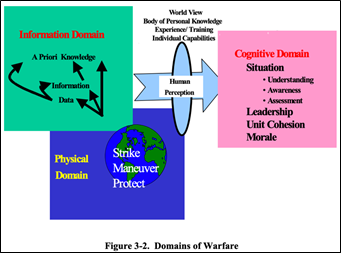 Image: Initial U.S. Conception of Cognitive Domain in Warfare. (Source: Department of Defense report to Congress, July 27, 2001.)
Image: Initial U.S. Conception of Cognitive Domain in Warfare. (Source: Department of Defense report to Congress, July 27, 2001.)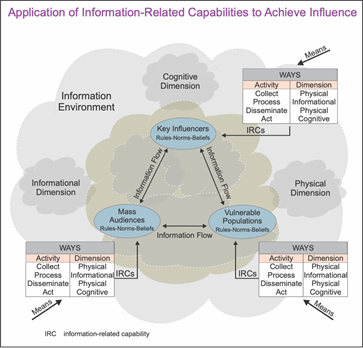 Image: Recent U.S. Conception of the Role of the Cognitive Domain in Influence Operations. (Source: Joint Chiefs of Staff, November 2012.)
Image: Recent U.S. Conception of the Role of the Cognitive Domain in Influence Operations. (Source: Joint Chiefs of Staff, November 2012.)
 Image: Initial U.S. Conception of Cognitive Domain in Warfare. (Source: Department of Defense report to Congress, July 27, 2001.)
Image: Initial U.S. Conception of Cognitive Domain in Warfare. (Source: Department of Defense report to Congress, July 27, 2001.) Image: Recent U.S. Conception of the Role of the Cognitive Domain in Influence Operations. (Source: Joint Chiefs of Staff, November 2012.)
Image: Recent U.S. Conception of the Role of the Cognitive Domain in Influence Operations. (Source: Joint Chiefs of Staff, November 2012.)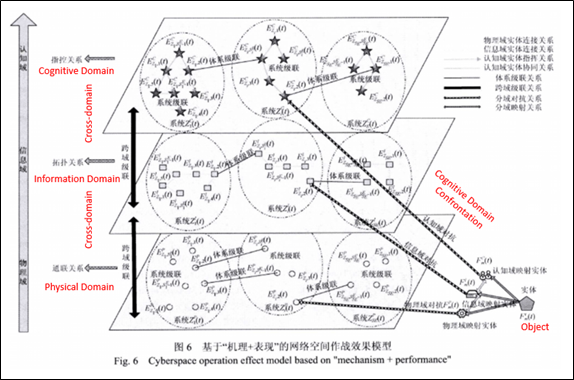 Image: Chinese Conception of the Role of the Cognitive Domain in Cyber Operations. (Source: Journal of System Simulation, [系统仿真学报] September 2017.)
Image: Chinese Conception of the Role of the Cognitive Domain in Cyber Operations. (Source: Journal of System Simulation, [系统仿真学报] September 2017.)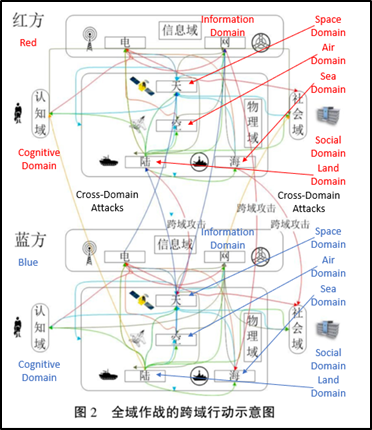 Image: Chinese Conception of Cognitive Domain Links to Other Domains. (Source: Military Operations Research and Systems Engineering, [军事运筹与系统工程], January 2018.)
Image: Chinese Conception of Cognitive Domain Links to Other Domains. (Source: Military Operations Research and Systems Engineering, [军事运筹与系统工程], January 2018.)
Applications of Cognitive Domain Operations
Solid evidence exists that the PLA is seeking to move into real-world application of cognitive domain operations. One such example is a 2018 article about the hardware requirements for cognitive domain operations. [22] The article was written by computer engineers in Base 311 (Unit 61716), the PLA’s leading psychological warfare unit under the Strategic Support Force (SSF), which was likely responsible for disinformation during the Taiwan election. Notably, the article was drafted in May and published in October, just as China was ramping up its interference. The article explicitly referenced Facebook, Twitter and LINE—all platforms China reportedly exploited against Taiwan and (except LINE) Hong Kong—and described social media as “a constantly open system that is highly inclusive and transcends the boundaries of national borders, cultural barriers and media.” [23]
The authors point out several shortcomings that the PLA is facing, and note that the PLA has “little research on the technology and equipment for cognitive domain operations on mainstream social networking platforms.” [24] They write that China needs to improve its big data, natural language processing, and deep learning capabilities, with multiple goals in mind: conducting subliminal messaging (阈下信息植入, yuxia xinxi zhiru), employing “voice information synthesis technology” (语音信息合成, yuyin xinxi hecheng), disseminating “network propaganda” (网络宣传, wangluo xuanchuan), and analyzing internet users’ sentiments.[ 25] The article also raises the prospects of buying or renting equipment through military-civil fusion to reduce costs while “ensuring secrecy,” and highlights the importance of “improving the overall operational capabilities of professional cognitive domain combat forces.” [26]
The PLA has also begun patenting technologies dealing with the cognitive domain since at least 2018, again reinforcing the real-world application of this concept. [27] These examples clearly indicate the PLA is developing specialized technologies and training personnel to manipulate foreign social media platforms under the rubric of cognitive domain operations.
A New Holistic Concept Subsuming Previous Research
Cognitive domain operations now appear to be subsuming many previously distinct lines of effort under the PLA’s psychological warfare program. For example, subliminal messaging is specifically referenced as a key technology for cognitive domain operations by the aforementioned 2014 AMS book, 2018 NUDT and 2018 SSF Base 311 articles. There has been a clear line of effort by NUDT over the last 10 years, following the broader PLA shift from a defensive to an offensive mindset, that included research on how to use subliminal messaging to reduce PLA soldiers’ resistance to indoctrination. Some of these tactics were recently tested on NUDT students in a class on the “three warfares.” [28] NDUT researched video manipulation during 2010-2011, and a December 2011 article proposed using “ audio-visual technology to imitate the voice of the national leadership and battlefield commanders to mislead the adversary’s decision-makers into wrong decisions.” [29] This video editing required “sound-image synthesis technology” (声像合成技术, shengxiang hecheng jishu)—a term that resembles other PLA references to “voice information synthesis technology,” and seems to indicate the development of building blocks for deep fakes. [30]
Disinformation is a Key Feature
Disinformation (虚假信息, xujia xinxi) has always been a component of the PLA’s information warfare strategy and appears to be a key, though implicit, feature of cognitive domain operations. [31] A 2013 AMS teaching guide for information operations and psychological warfare identifies methods such as “creating information chaos… implanting disinformation and erroneous information into the enemy’s information system, and causing the enemy’s command to make the wrong decisions and commands” in peacetime and wartime. [32] The December 2011 article on video manipulation discusses creating “distorted videos” (篡改视频, cuangai shipin), fake videos (虚拟视频, xuni shipin) and “videos for deterrence” (视频威慑, shipin weishe), even identifying situations and targets for disinformation, including peacetime operations, as shown in the table below. [33] This theoretical framework correlates with the PLA Air Force’s use of reportedly fake images of H-6K bombers flying close to Taiwanese mountains as propaganda material to threaten Taiwan. [34]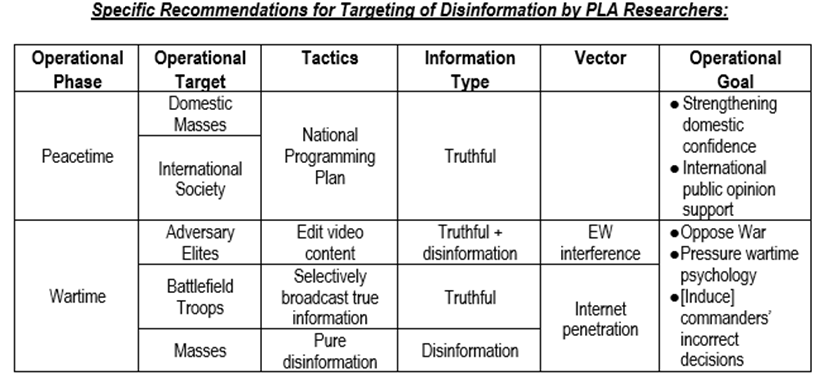 Image: Specific Recommendations for Targeting of Disinformation by PLA Researchers. (Source: Fire Control and Command Control, [火力与指挥控制], December 2011.)
Image: Specific Recommendations for Targeting of Disinformation by PLA Researchers. (Source: Fire Control and Command Control, [火力与指挥控制], December 2011.)
 Image: Specific Recommendations for Targeting of Disinformation by PLA Researchers. (Source: Fire Control and Command Control, [火力与指挥控制], December 2011.)
Image: Specific Recommendations for Targeting of Disinformation by PLA Researchers. (Source: Fire Control and Command Control, [火力与指挥控制], December 2011.)
Real World Evidence
Taiwan is the best case study of the real-world applications of the PLA’s cognitive domain operations, and highlights one clear vector: social media disinformation. The Taiwan government has claimed that China interfered with the island’s November 2018 election through a variety of means, employing both traditional and social media. [35] Anonymous Taiwanese national security officials have claimed the SSF was the driving force behind the election interference campaign, and reports have identified Beijing artificially generating support for its preferred candidates on social media. [36] Researchers have suggested the CCP Propaganda Department, CCP United Front Work Department, and perhaps private contractors could have played a role as well. [37]
One PLA article provides insight into how the Chinese military may have prepared for cognitive domain operations against Taiwan. A 2017 article by a graduate student at the Nanjing Political Institute (now under NDU as the military institution’s Political Academy) created a playbook for how the Chinese military could “localize” “targeted communications” towards Taiwan on social media. [38] The author specifically focuses the article on PTT, a popular Reddit-like Taiwanese bulletin board service, and explains how to alter typical mainland Mandarin sentence structure and vocabulary to sound more like that of Southern Min, the dialect used in Taiwan. The author adds that sounding local will reduce the emotional distance between the two sides, otherwise it is “very easy to spot and will attract the attention of other Internet users.” [39]
Conclusion
Cognitive domain operations appear to be the key operational concept behind China’s embrace of social media disinformation. Chinese information operations and psychological warfare—what the West would call influence operations—have a long history, and it should come as no surprise that the CCP is embracing the newest and most effective tools for mass communications. Social media could greatly increase the ability of the PLA to target tailored messaging to specific audiences based on artificial intelligence (AI) and big data analytics. For example, a June 2019 article co-authored by SSF Base 311 personnel called for the PLA to abandon the use of “sockpuppets” (马甲, majia), or false online identities used for deception, in favor of AI-enabled “intelligent public opinion guidance” (网络舆情智能引导, wangluoyuqing zhinengyindao) software that has the ability to automatically and adaptively generate content and select the optimal time and method for coordinated posts. [40] It remains to be seen how effective China will be in capitalizing on these capabilities. The experience of Taiwan, combined with recent reports of Chinese state-backed disinformation campaigns against Hong Kong, suggests that CCP efforts in this realm are just getting started. It is worth wondering where the PLA will employ its cognitive domain operations toolkit next.
Nathan Beauchamp-Mustafaga is a Policy Analyst at the nonprofit, nonpartisan RAND Corporation. He is currently working on a larger report with Michael Chase for the Foreign Policy Institute at Johns Hopkins SAIS on how the Chinese military uses social media for influence operations.
No comments:
Post a Comment